How Much Does Indian Ink Art Cost to Make
What is Ink? Ink is a liquid with a pigment or dye based colouring used for painting, drawing and printmaking purposes. The characteristics of ink vary wildly to adapt specific applications. The term 'ink' is used to describe thick buttery substances, likewise equally liquids that will drip from a pipette. Lightfast inks tend to be made with pigments held within a clear folder, but there are as well non-lightfast inks fabricated from dyes available – which can offer vibrant colour that can be used for work that is not exposed to lots of low-cal – such as sketchbook work, or work intended for reproduction.
What's the Deviation Between Ink and Paint?
The very best fine art paints are formulated to offer you as many unmarried pigment colours so that you lot tin can mix exactly what hue you require, without any compromise of vibrancy. They are adaptable and can be mixed with mediums for thick impasto brush marks, or thinned out to optimise transparency and luminosity. Inks tend to be less adaptable. They are formulated for more specific art processes – such as for pen piece of work, printmaking or intense splashes of colour to exist applied with a brush or pipette. There are fewer inks than there are paints that can bridge a variety of image making processes. Ink based processes tend to be altered by the option of tools used, rather than modifying the colour itself, although there are mediums available for some of the inks described below.

While watercolour from a tube is usually diluted a little with water prior to awarding, ink is more frequently applied neat.
Drawing, Painting and Calligraphy Inks
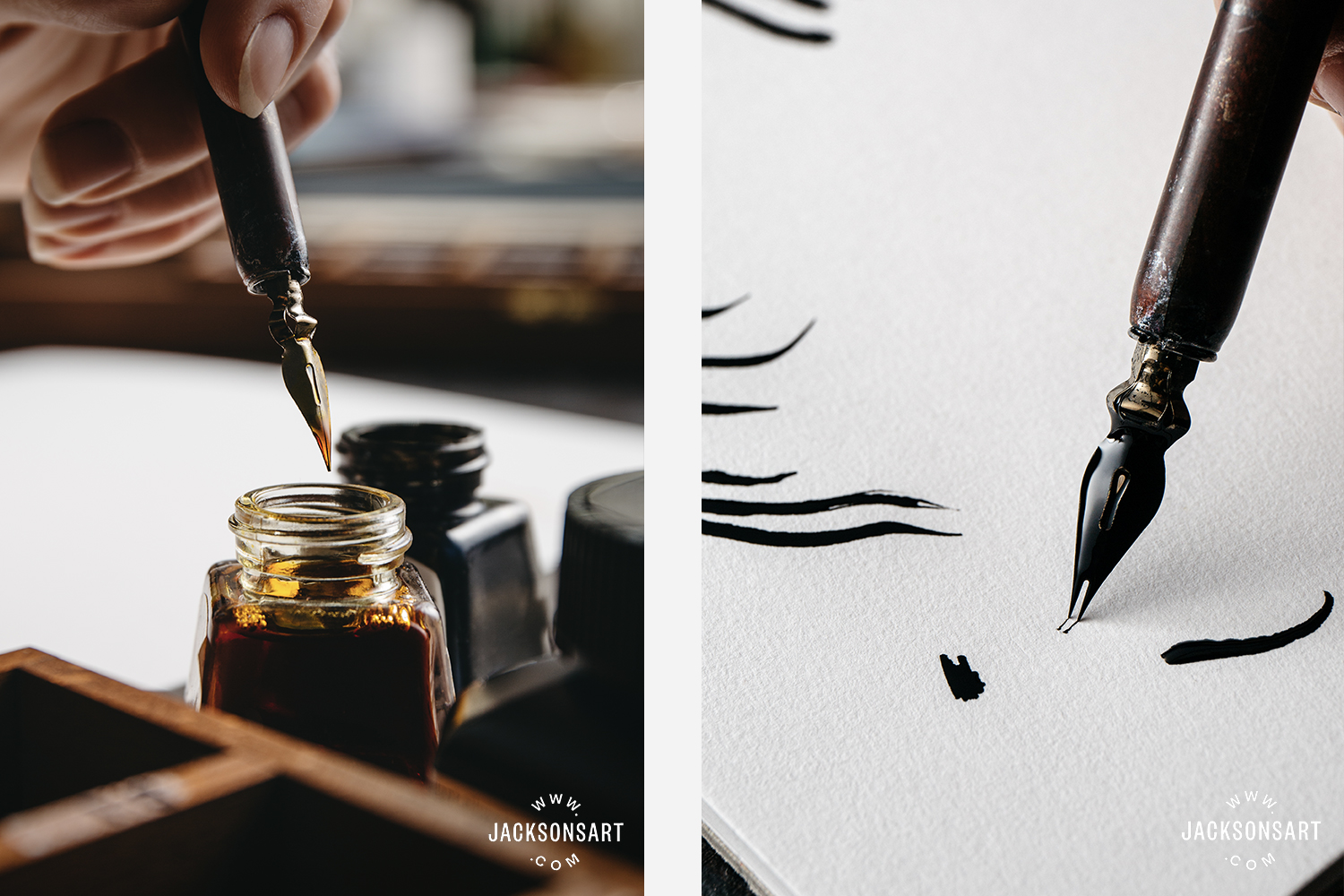
Inks formulated for drawing, painting or calligraphy are ordinarily very fluid (somewhere between milk and water in consistency) and vary in transparency, lightfastness and water solubility. Drawing inks tin can be pigment or dye based – generally dye based inks are less lightfast than those made with paint, and may fade with prolonged exposure to sunlight. Waterproof drawing inks tend to be made with paint and shellac binder (a resin secreted by the lac bug) or an acrylic emulsion, and can be diluted with water while wet. Rewettable water soluble inks offer an open up working time, and are suitable for use with refillable fountain pens. In that location are also permanent h2o soluble inks than can be diluted in h2o but one time dry out can not be rewetted, which are usually better suited to castor or dip pen work.
Calligraphy inks are as well available waterproof or water soluble. Dip pens tin exist used with either while fountain pens are best used with water soluble ink to avoid the ink drying and clogging the pen. Traditional calligraphy inks are more than opaque than cartoon inks.
Drawing Ink Tools
For these inks, getting started requires minimal equipment. Showtime of all, y'all need to determine which tool you wish to utilise to apply your ink – a pen or brush, or a combination. A brush volition permit you to vary the width of your marking depending on the pressure y'all apply, and it's besides piece of cake to control the colour saturation. Pens on the other hand are best for a compatible application of color – both in terms of colour saturation and the width of your line. At that place are a wide range of nibs for dip pens to allow you to make a diverseness of dissimilar marks. If you're looking for suitable brushes, the best to apply for inks are soft haired watercolour brushes, which are bachelor with natural or synthetic pilus. Hake brushes are traditional goat hair brushes that can be used for traditional sumi-e ink painting techniques.
Drawing Ink Surfaces
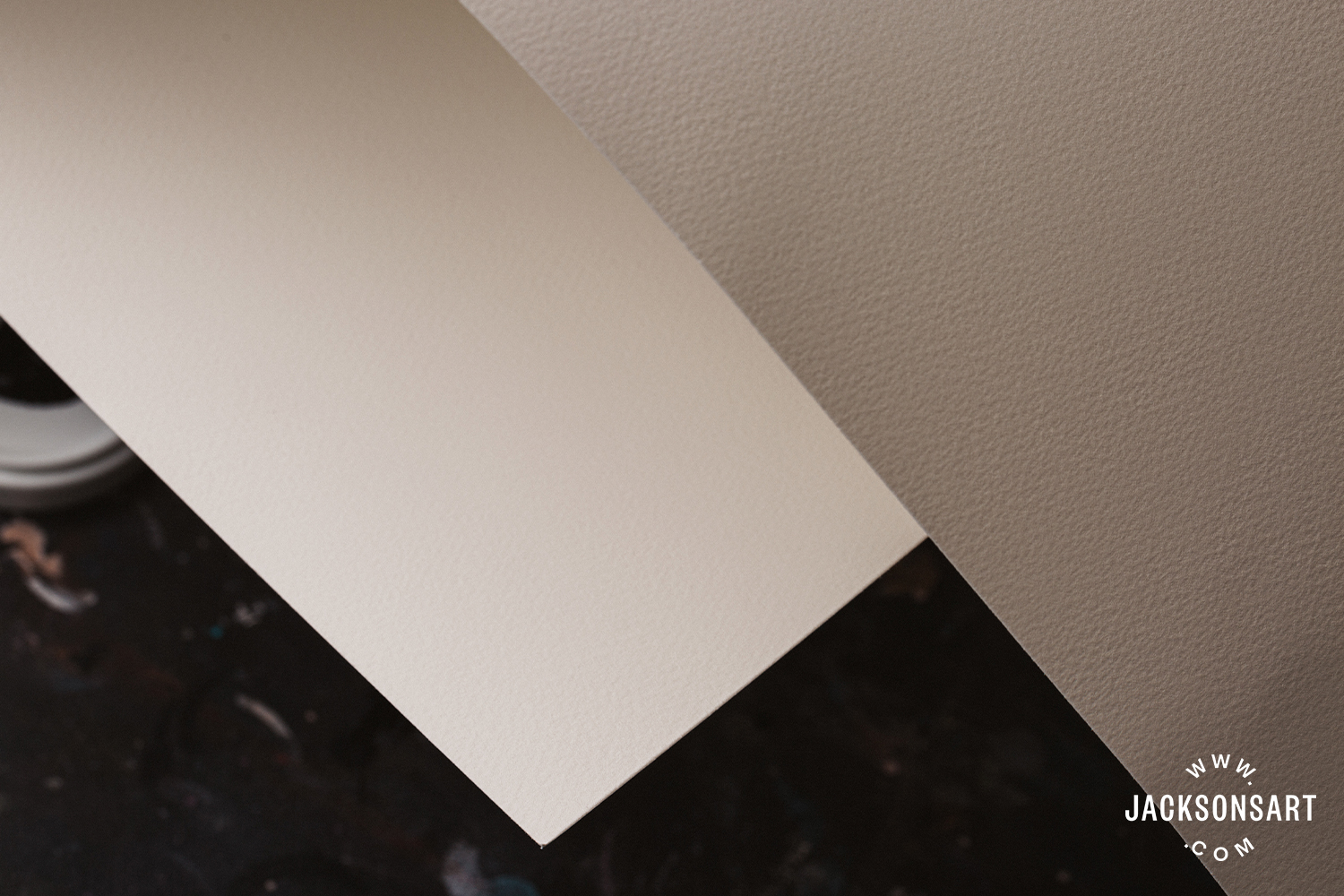
Once you have decided on your tools, you'll need something to work on. Paper is an obvious choice – and any kind of newspaper can be used. The color, texture and absorbency of the paper will affect upon how the ink behaves when applied and the overall finished results. If a paper is non sized or is soft sized (such equally printmaking newspaper), cartoon ink is likely to bleed or feather on information technology when applied. Harder sized watercolour papers may experience slightly scratchy when drawn on with a pen and more suited to crisp fine lines. These differences will play a office in the qualities of your finished work. Other surfaces you can work on are gesso panels – which is smooth with a degree of absorbency, or canvas – the weave of which gives a texture perfect for applying ink with a brush.
Additional extras you may wish to invest in might be blotting paper (if using a pen), a ceramic palette and a water pot.
Indian Ink and Chinese Ink
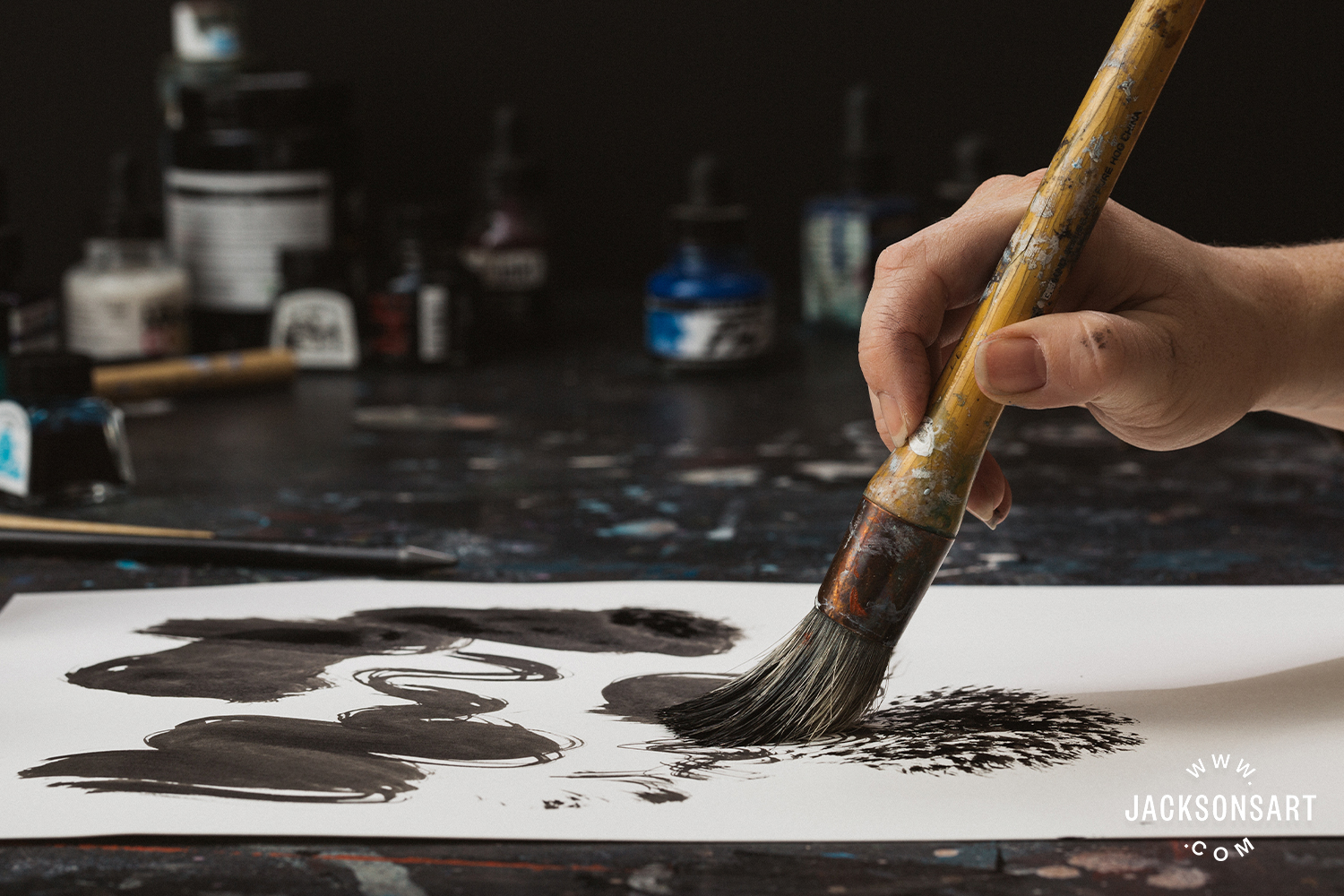
Blackness Indian or Chinese ink usually uses lamp black pigment, bound in a gum similar binder, which becomes liquid when mixed with water. The very outset Indian inks did not even have a binder; they were but made of soot and water. Its use dates back to the tertiary Millennium B.C, during Neolithic People's republic of china. Information technology was used originally past Chinese painters only oft the materials were imported from India, which is why it is known sometimes as Chinese ink, and sometimes as Indian ink. Chinese Ink is usually liquid, only information technology as well available in a stick, which volition turn to a workable ink when ground into an ink stone by hand with a footling h2o. Every bit with drawing inks, Indian inks are either h2o soluble or water proof, depending on the amount of shellac in the ink itself (the more shellac at that place is the more waterproof the ink becomes). Watersoluble Indian Inks tin can be used in some pens and airbushes only information technology is worth checking the manufacturer's individual advice to ensure that the ink is compatible. Indian ink can also be applied with bamboo pens as well as brushes. It will adhere to paper, canvas, wood and fabric.
Indian inks are not usually mixed with mediums, still watercolour mediums could be explored with water soluble Indian Inks, and shellac can exist added to shellac based Indian Inks to increase their gloss when dry.
Acrylic Ink and Airbrush Ink
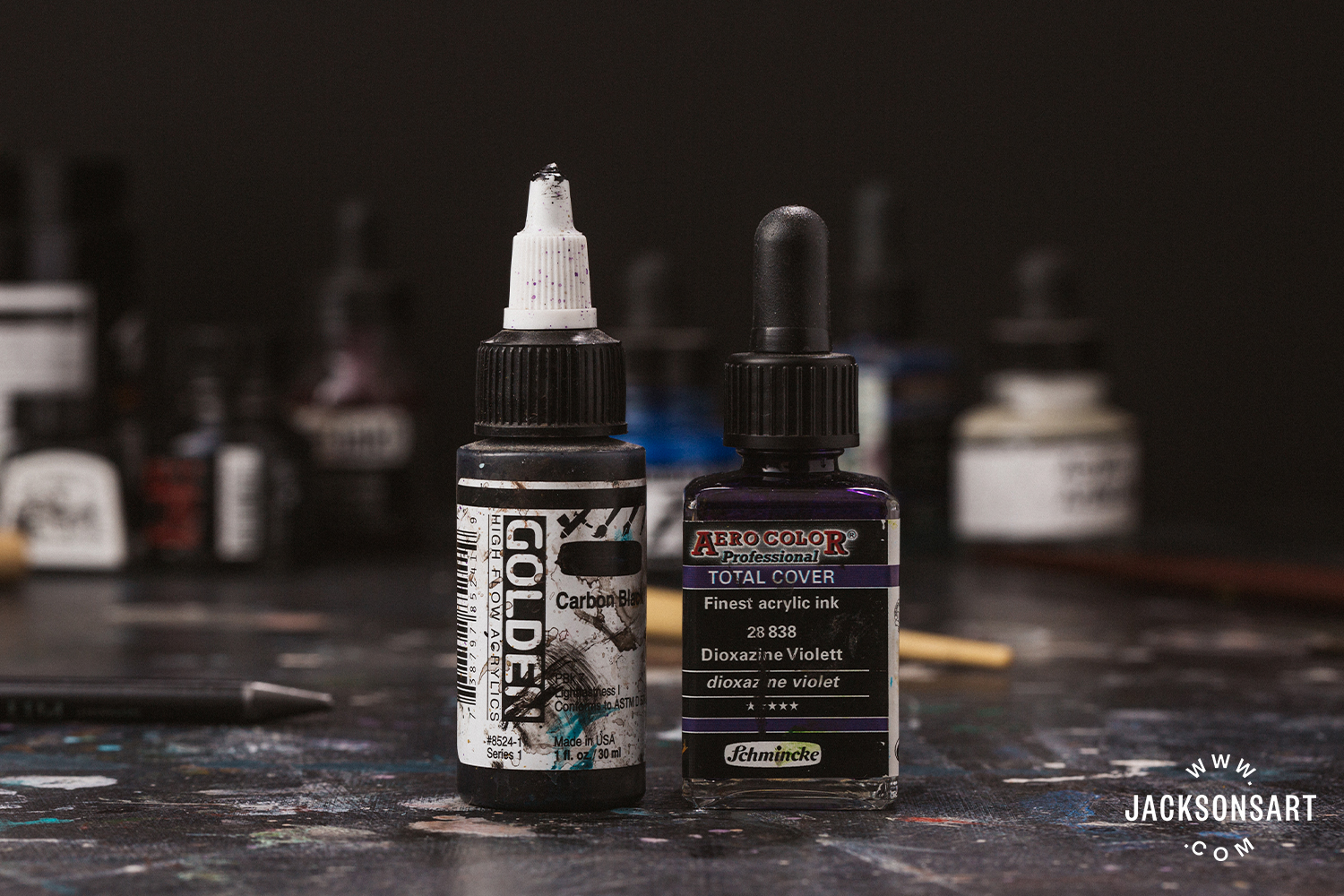
Airbrush inks are the lowest possible viscosity ink, guaranteeing consistent flow and maximum control of application, with minimal risk of clogging. Airbrush inks are acrylic based and tin can be practical to whatsoever surface. They dry waterproof, and can also exist used with dip pens and brushes. To outset airbrushing, all you demand is your airbrush equipment and your airbrush colours, as well equally the surface you wish to use your color on, which could be paper, bill of fare, sheet or metal. You may also wish to invest in a spraying booth to keep your spraying work contained.
Alcohol Ink

Alcohol inks are fast-drying alcohol-based dye inks that create vivid flowing textures, popularly used in pour painting. One time the ink is applied, the booze evaporates, leaving the dye behind. Once it dries information technology can be re-moisture with rubbing booze, creating unique and versatile effects that tin't exist achieved with water-based products, such as acrylic paint. Alcohol inks can be applied with a brush or pen, or dropped direct from the pipette in the canteen, on to paper, card, canvass or panel. Brushes and tools should exist blotted on a paper towel before rinsed with lxx% alcohol solution.
Ink for Relief/Intaglio Print
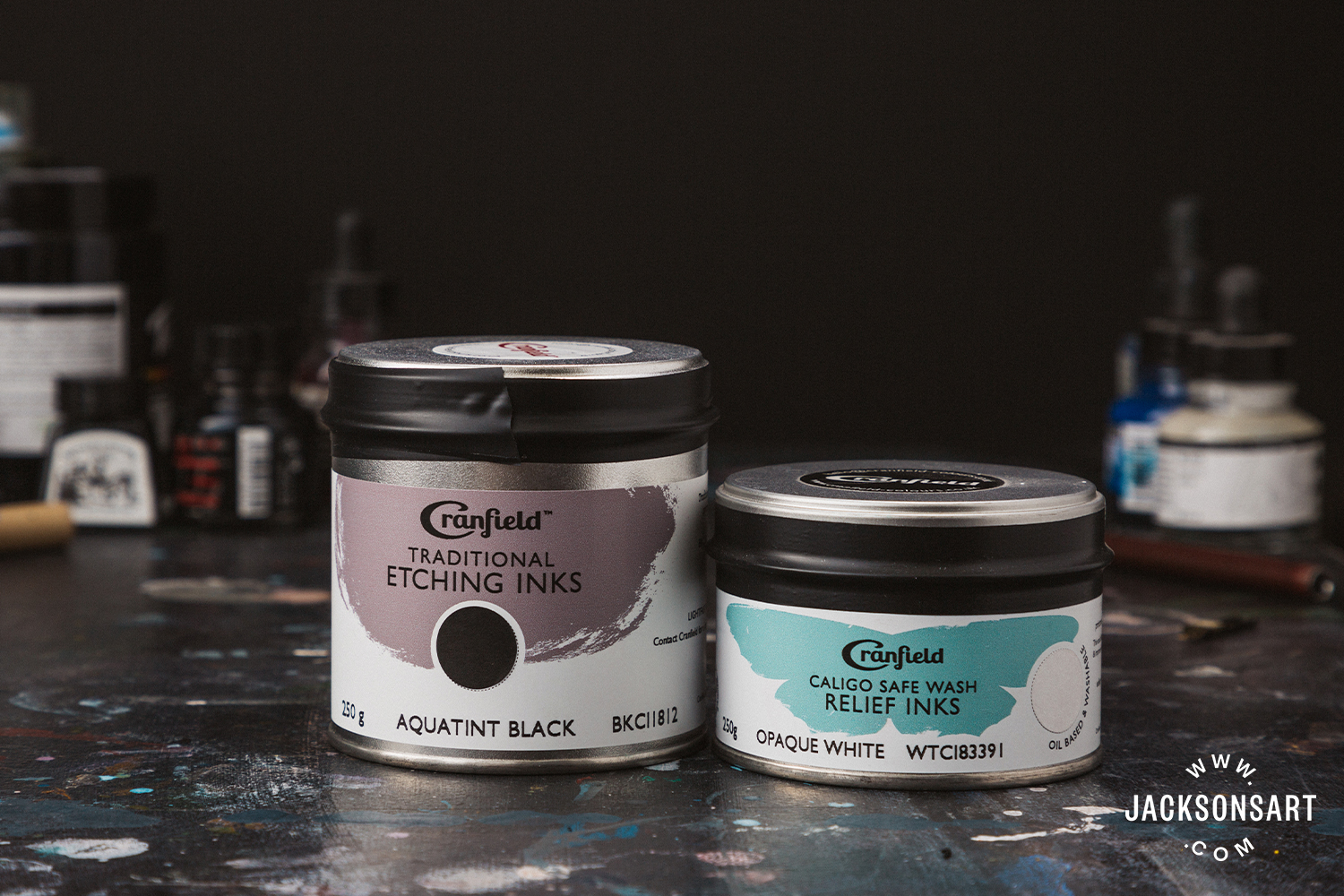
The inks y'all tin use for relief and intaglio printmaking processes are much higher viscosity than drawing inks, with a consistency similar to neat oil or acrylic pigment. Relief inks are bachelor in water, acrylic and oil based varieties, while intaglio press is usually done with stiffer oil based ink, with Akua Intaglio Ink offering a soy based culling that can be thinned with water. H2o washable oil based inks negate the need for using harsh solvents during the make clean upwards operation.
In order to start relief printing, y'all demand a matrix such equally wood or lino which you would carve into using either lino or wood cutting tools, or wood engraving tools. A roller is ordinarily used to utilize a thin and even layer of color to your matrix before yous place a sheet of paper over your block and employ pressure to brand an imprint. For Japanese woodblock printing, a much thinner, water based ink or watercolour paint is used and applied with a special purpose made, soft natural hair brush.
Intaglio printing involves engraving into a matrix such as copper, drypoint card or an acrylic canvas. Y'all apply ink to the surface of your plate before simultaneously removing excess ink and pushing ink into the engraving lines of your image by dabbing your plate with a ball of scrim or tarlatan. A print is made by placing a damp sheet of paper on to the plate and applying pressure using an etching press, and then that the ink transfers to your paper.
For more in depth data on how to get started in linocut visit Linocut Printmaking for Beginners – What You Demand to Get Started
Further reading on Etching can be constitute hither.
Screenprinting Ink
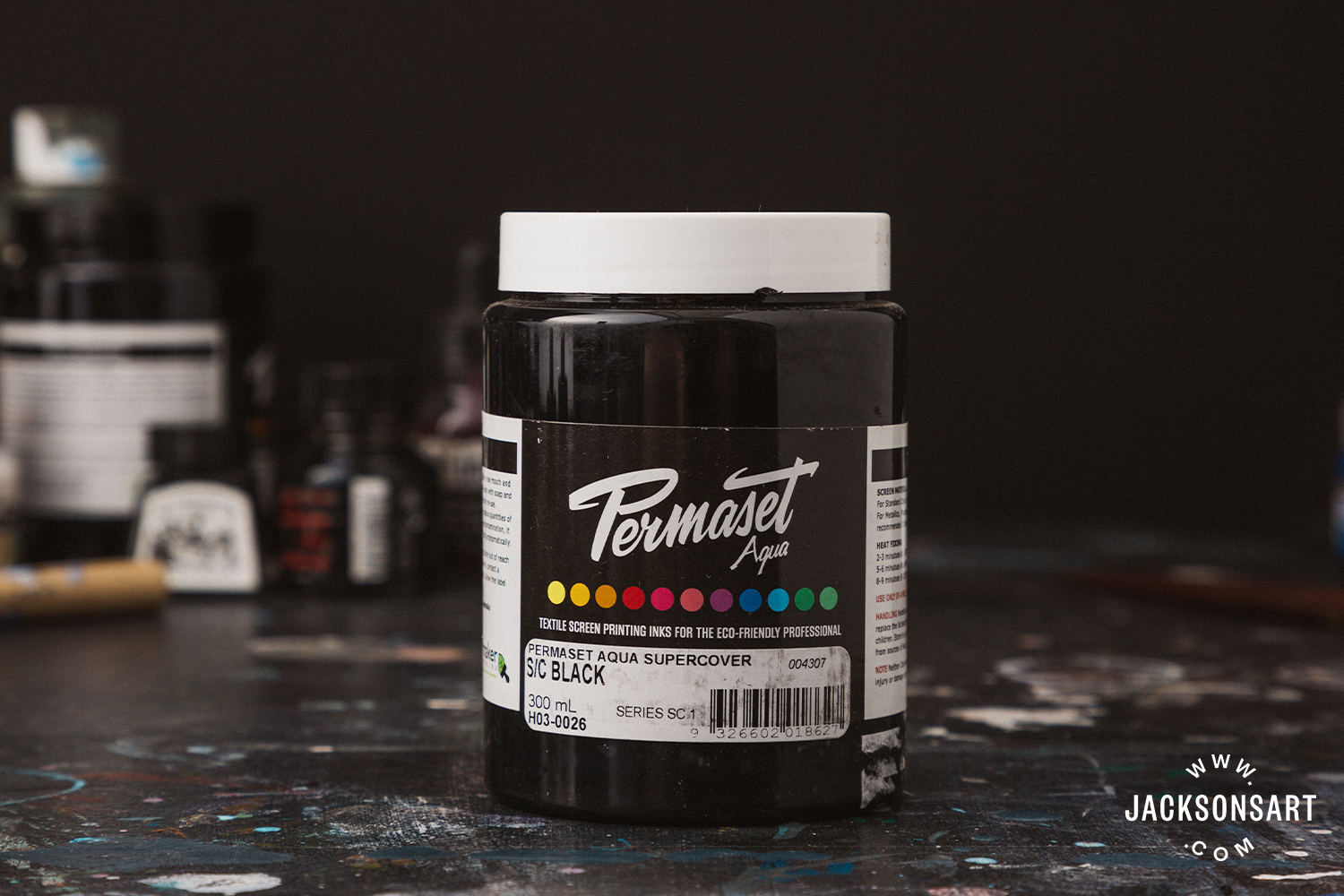
Screen printing ink can either exist water or oil based. Water based screen printing ink is thinner and pourable, while oil based ink tends to be thicker, simply with a lower tack than relief or intaglio ink. Plastisol inks are take a PVC folder that are heat set and are popular for use when press garments, but crave solvents for cleaning. All screenprint inks are formulated to brand information technology easy to command with a squeegee, and as well push through a fine mesh stretched over a frame. In club to create a certain shape in a screenprint a mask is fabricated to ensure ink is simply applied in the desired places. Screen printing tin exist washed on a multitude of surfaces, including paper, plastic or cloth. A number of acrylic screen printing mediums are available that can be mixed with regular acrylic pigment to increase their tack and suitability for screen printing. Ready fabricated screen printing inks are available, some of which are formulated primarily for textile printing.
To view everything yous demand to become started in screen printmaking methods, visit the Screenprinting department.
Lithography Ink
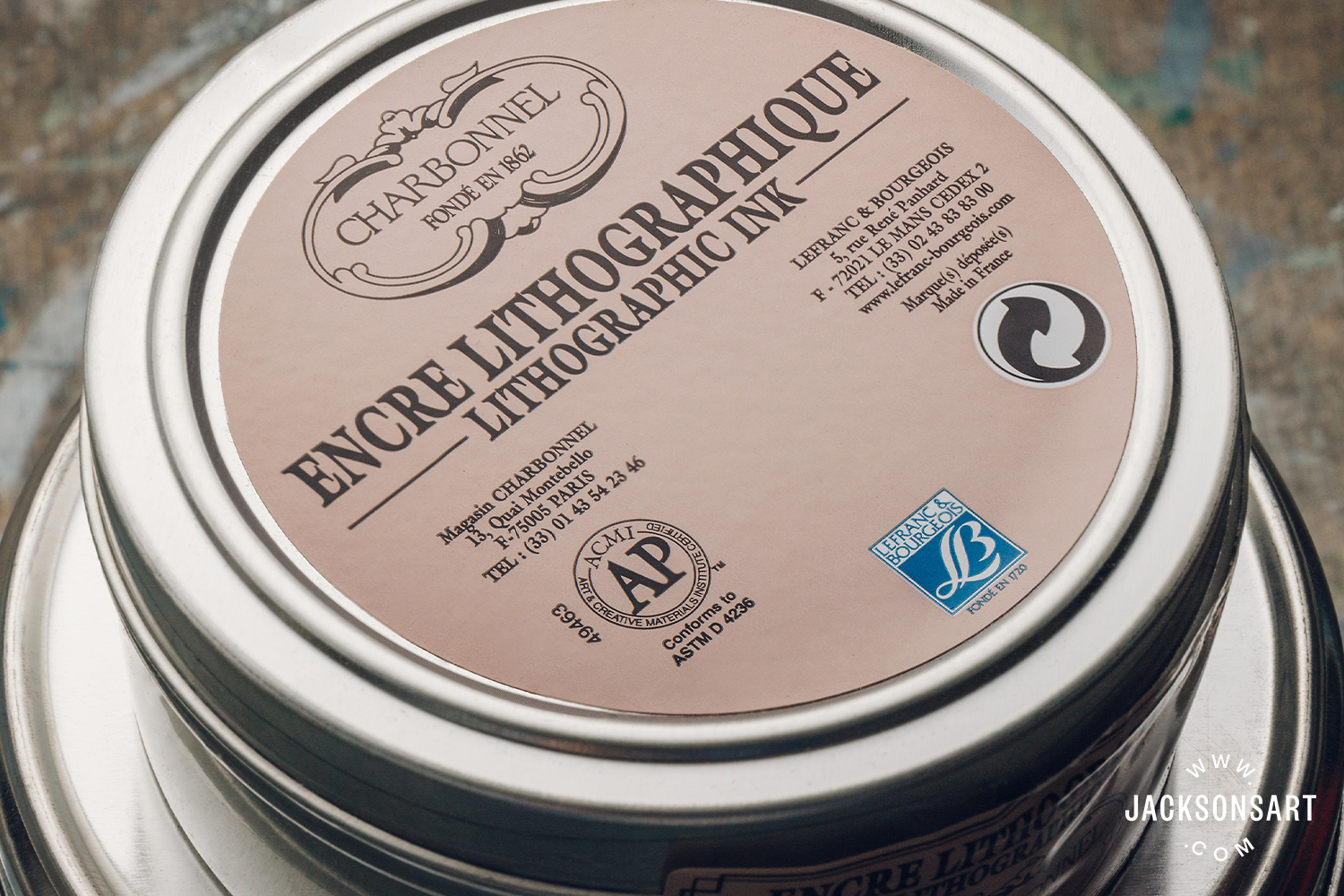
Lithography is a printmaking procedure which involves cartoon an image using something greasy on a plate, and then coating the plate with h2o and mucilage arabic, earlier inking the plate up with oil based ink and taking a print. The water and gum standard arabic repel the oil based ink and so that just the desired image is picked up by the ink. The process requires a high amount of pressure, offered by a lithographic printing printing. Traditional lithography involves the use of chemicals such as nitric acid, gum standard arabic and alum for preparing the plate; these volition help to sensitise the plate to begin with, and so prepare the greasy marks y'all make to create the image. More primitive versions of the lithographic procedure accept been discovered, using cola or vinegar instead of acids, on aluminium instead of stone. 'Kitchen lithography' can be done at dwelling without the demand for a printing press. Lithography is a diverse procedure every bit you can draw your paradigm with a wide variety of materials, from crayons to paint, and so resulting prints can look only like paintings or drawings, with the benefit of being able to print multiples of the image.
Lithography requires a very thin layer of ink, and so consequently lithographic ink is highly pigmented, with a relatively stiff oil binder that will non squeeze out of place when force per unit area is applied to brand an impression. Relief ink has been known to be used in place of especially formulated lithographic ink in the past, but it's cardinal that a lot less ink is used than in relief printing to maintain command over the procedure. Because lithography works on the principle that oil and water exercise not mix, it is of import to not use water-washable printmaking inks for lithography, as the water/gum arabic solution practical to the plate during the inking upward process volition dilute the ink you employ to the stone. This will brand it possible for ink to adhere to the whole picture plane, when the procedure requires some degree of oil repelling then that oil just adheres on the image of your impress.
From the simplicity of soot mixed with water, to PVC based colour that remains liquid until set with heat, the variety to be institute within the world of ink is about as wide as y'all tin can go – and this is earlier we fifty-fifty consider the range of colours available. Whether you're making a simple even so expressive brush painting, or planning a complex multi-layered lithograph, the qualities of the ink you choose to work with are paramount for ensuring a satisfying process and end event.
Further Reading
2 Illustrators Describe With Jackson'south Indian Ink
Fluid Painting With Jackson'due south Alcohol Inks
Jackson's Metallic Drawing Inks on Blackness Khadi Watercolour Paper
In Conversation with Michael Craine from Cranfield Colours
Brush Pens: The Definitive Guide
A Guide to Dip Pens and Cartoon Ink
Monotype Printmaking for Beginners
Ink at Jacksonsart.com
Source: https://www.jacksonsart.com/blog/2021/11/22/a-guide-to-inks/
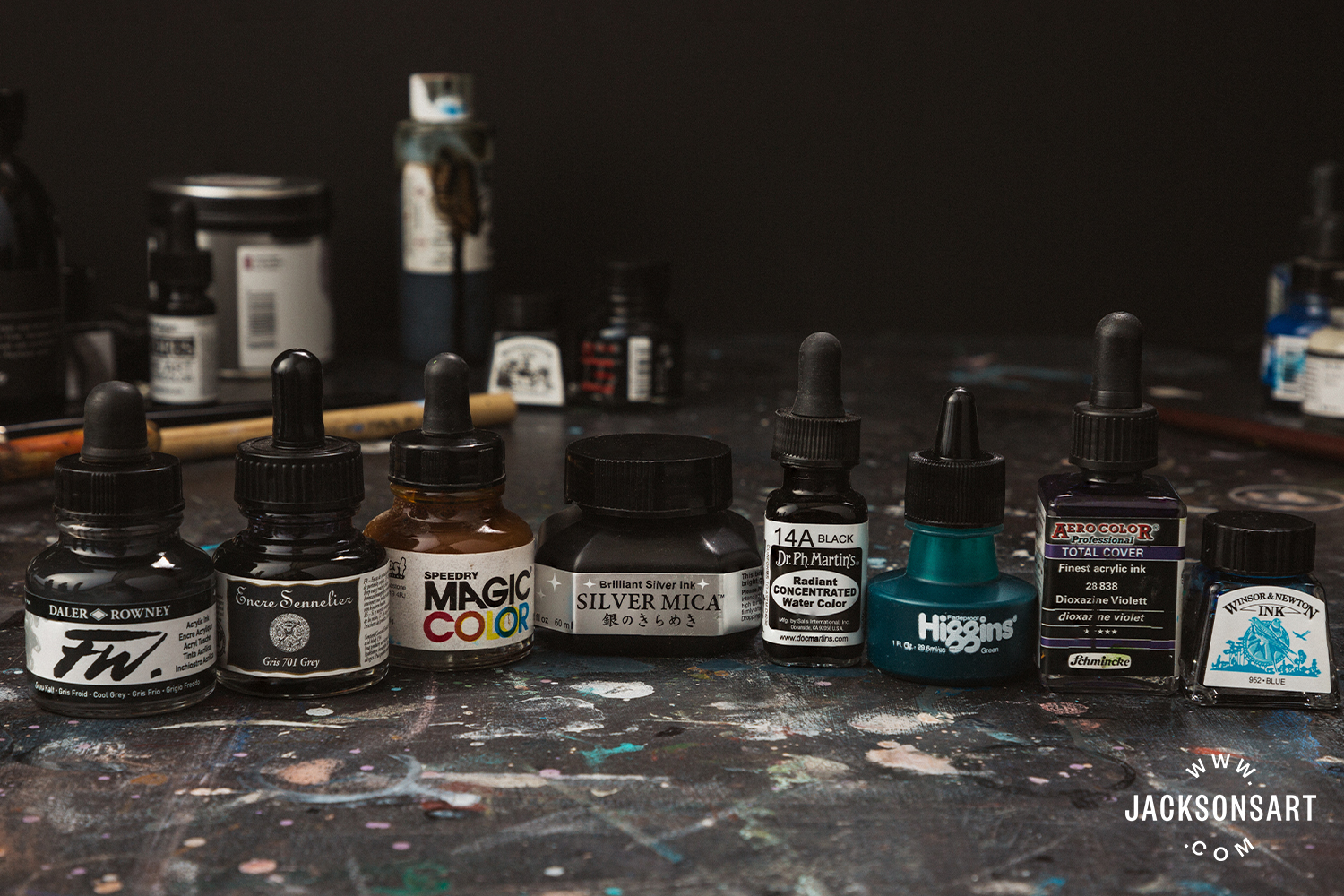

0 Response to "How Much Does Indian Ink Art Cost to Make"
Post a Comment